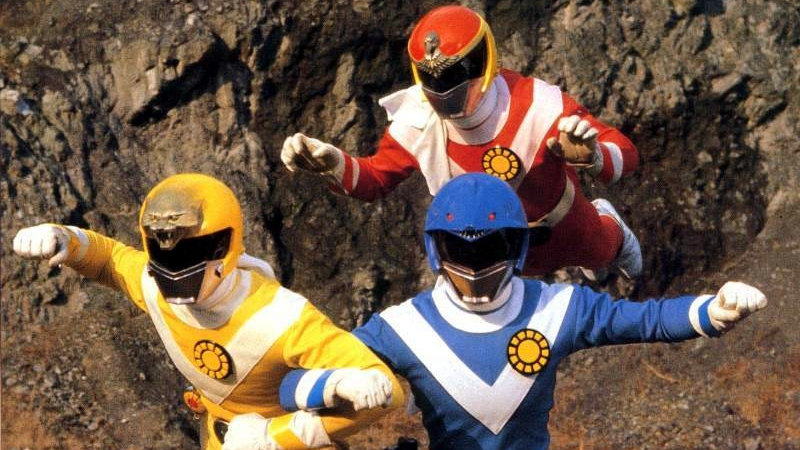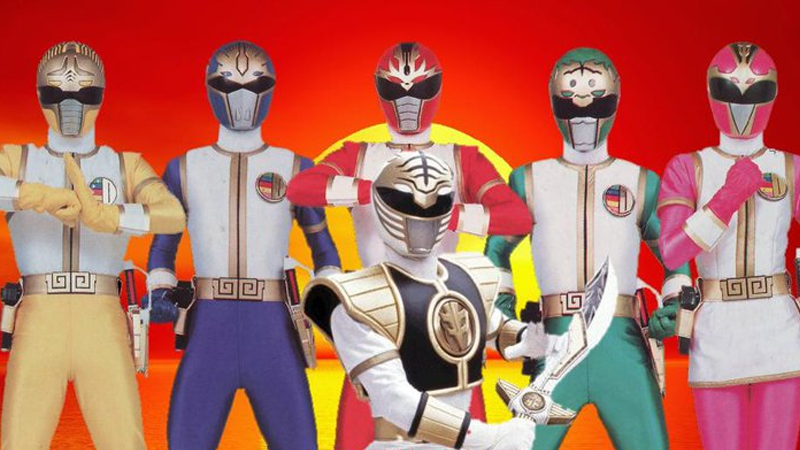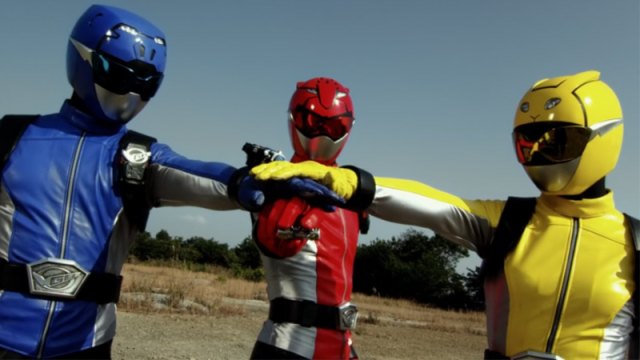As many know, the heroes of Power Rangers aren’t a wholly western creation — they’re really the stars of Super Sentai, a Japanese kid’s franchise that’s over four decades old. Since Power Rangers began, nearly every Super Sentai series since has been adapted for the show, but not all of them have made it over. These are the Power Ranger shows that could have been.
Taiyo Sentai Sun Vulcan (Solar Squadron Sun Vulcan)

The three heroes of Sun Vulcan: Red VulEagle Ryuusuke, Blue VulShark Kin’ya, and Yellow VulPanther, Asao.
First Aired: 1981
The world of Power Rangers almost had a completely different start — in fact, the series as we know it today would have never have existed, if Marvel’s Stan Lee had gotten his way. Haim Saban was not the first person to try and bring Super Sentai over to the West.
Marvel tried, as part of a deal with Toei that culminated in the creation of the infamous Japanese Spider-Man show. As well as Spider-Man, the collaboration between the two companies also saw Marvel partially fund three Super Sentai series: Battle Fever J (which featured a character loosely based on the Marvel hero of the same name, Miss America), Denshi Sentai Denziman, and Taiyo Sentai Sun Vulcan.
As a way to profit further over the deal, Lee looked for a way to bring that third show, Sun Vulcan, to the West — in fact, many believe a pilot for the show, which would have featured American actors dubbed over the original footage, exists somewhere. But according to Lee himself, no broadcaster would pick the series up, and Marvel and Toei’s collaboration came to an end… ultimately laying the groundwork for the show we know today as Power Rangers to actually happen.
Choudenshi Bioman (Super Electronic Bioman)
First Aired: 1984
Saban actually tried several times to bring Super Sentai westward before striking gold with Zyuranger. His first attempt was an adaptation of Bioman, which followed five descendants — Shirou, Shingo, Ryuuta, Mika, and Hikaru — of humans doused with mystical, power-granting Bio-Particles when the all-powerful Bio Robo landed on Earth centuries beforehand. Their quest: to protect the planet from the evil Neo Empire Gear, a race of advanced cyborgs lead by the hilariously named Doctor Man, who believed they had the right to rule Earth.
Although it’s unknown whether it’s a dub of Bioman with English actors, or a full fledged adaptation with new footage spliced in a la Mighty Morphin’ Power Rangers, a pilot of Saban’s version of the show, called Bio-Man, does actually exist. In it, the Biomen were kids with identical “bio-rhythms” who fought against a cyborg called Zadat, but actors’ strikes and contract disputes lead to the series being scrapped.
Choujin Sentai Jetman (Birdman Squadron Jetman)
First Aired: 1991
By 1991, the Super Sentai franchise was actually in decline — steadily decreasing ratings meant that, as production on Jetman began, the cast and crew were lead to believe that, at least for the foreseeable future, it would be the last Super Sentai show full stop.
The “last hurrah” nature of the show meant the creative team behind Jetman tried to shake up the typical format of a Super Sentai show, borrowing elements from soap operas (including a love triangle between three of the main heroes: Red Hawk Ryu, Black Condor Gai, and White Swan Kaori) in an attempt to draw in more viewers beyond the typical kid’s show audience.
It worked — really well. Super Sentai was “saved” by the re-ignited interest in the series spurred by Jetman‘s trendy dramatic subplots (Gai, the Black Condor, was seen as a heartthrob by Japanese housewives tuning in to the show with their kids), and would carry on as an annual franchise.
Saban would try again to adapt Super Sentai a few years later with an attempted pilot based on Jetman — but like Bio-Man, the plan was scrapped. Saban would only find success a year later, when he finally struck luck with an adaptation of Jetman‘s immediate successor, Kyoryu Sentai Zyuranger — kickstarting the Power Rangers franchise we all know and love today. If Jetman really had been the last Super Sentai series for a while, Power Rangers in the form we know it as would never have happened.
Gosei Sentai Dairanger (Five-Star Squadron Dairanger)

The Dairangers from left to Right: KirinRanger Kazu, TenmaRanger Shoji, RyuuRanger Ryo, KibaRanger Kou, ShishiRanger Daigo, and HououRanger Rin.
First Aired: 1993
Although Dairanger never got its own Power Rangers show, you might recognise quite a few elements from it. While the original series — which immediately followed Zyuranger in Japan — followed five youths whose high levels of Chi allowed them to turn into the Dairangers, mystical martial arts heroes who could fight off the evil Gorma tribe their ancestors fought centuries ago, that premise never made it over to Power Rangers… sort of.
The massive success of Mighty Morphin’ Power Rangers lead to production company Saban wanting to drag out the original cast — and Zyuranger action footage it had licensed — as much as possible. In fact, after running out of footage, Saban specifically went to Toei to request them to film a new half-season’s worth of footage using the Zyuranger suits and mecha. When even that footage was used up, instead of wholly adapting Dairanger, there was a compromise.
Saban re-used certain Zyuranger action footage and continued to film new live-action sequences with the Rangers out of costume, but repurposed the mecha footage from Dairanger as the team’s new robot upgrades, the Thunderzords (known in Dairanger as “Mythical Chi Beasts”).
Weirdly enough, one member of the Dairangers did come over as well: action footage of the sixth Dairanger, Kou the KibaRanger, was re-purposed so that Green Ranger Tommy Oliver in Power Rangers would transform to become the White Power Ranger. The original Dairanger suits would appear in Power Rangers for the first time as part of Power Rangers Super Megaforce in 2014, using the new footage shot with the suits for the series that it adapted, Kaizoku Sentai Gokaiger.
Tokumei Sentai Go-Busters (Special Operations Squadron Go-Busters)
First Aired: 2012
After compromising with Dairanger, Toei and Saban settled into a simple relationship: every year there’d be a new Super Sentai show, and every year it would get adapted into a new Power Rangers team. Then, after nearly 20 years, one show never made it over for reasons unknown. As several series has been adapted into two-season long shows, Saban was able to skip Go-Busters over for adaptation in favour of its successor, Zyuden Sentai Kyoryuger, which became 2015 and 2016’s Power Rangers Dino Charge and Super Charge, respectively.
Bizarrely enough, Go-Busters is perhaps one of the most Power Ranger-y seasons of Super Sentai ever made. Set in a near future where humanity thrives from the use of a renewable energy source called Enetron, the show follows the special missions of superpowered spies Hiromu, Ryuji, and Yoko (later joined by their mentor, Jin, and his android companion Beet. J. Stag). They’re tasked with protecting Earth’s supplies of Enetron from a maniacal AI known as Messiah, created in the same disaster that gave the heroes their powers.
Aside from the spy-genre angle being a play to western audiences, Go-Busters borrowed terminology directly from Power Rangers in a first for Super Sentail, such as referring to its mechas as “Megazords” and having the Go-Busters shout “Let’s Morphin!” and “It’s Morphin Time!” in English when they transformed.
Ressha Sentai ToQger (Train Squadron ToQger)
First Aired: 2014
Like Go-Busters before it, Ressha Sentai ToQger (pronounced “Toh-kyu-jer”) was passed over this year in favour of an adaptation the 2015 Super Sentai series Shuriken Sentai Ninninger, which just recently began in the West as Power Rangers Ninja Steel.
The ToQgers were young children who used the power of their imagination to turn into adults that guarded the magical Rainbow Train Line from attacks from the nefarious Shadow Line and its leader, Emperor Z, while on a quest to liberate their home town from the Shadow Line’s control. The imagination-based powers and generally goofy nature of the heroes compared to the more “serious” tone Power Rangers usually adopts is probably why the opportunity to skip ToQger over for ephemerally-popular Ninja rangers was taken.
